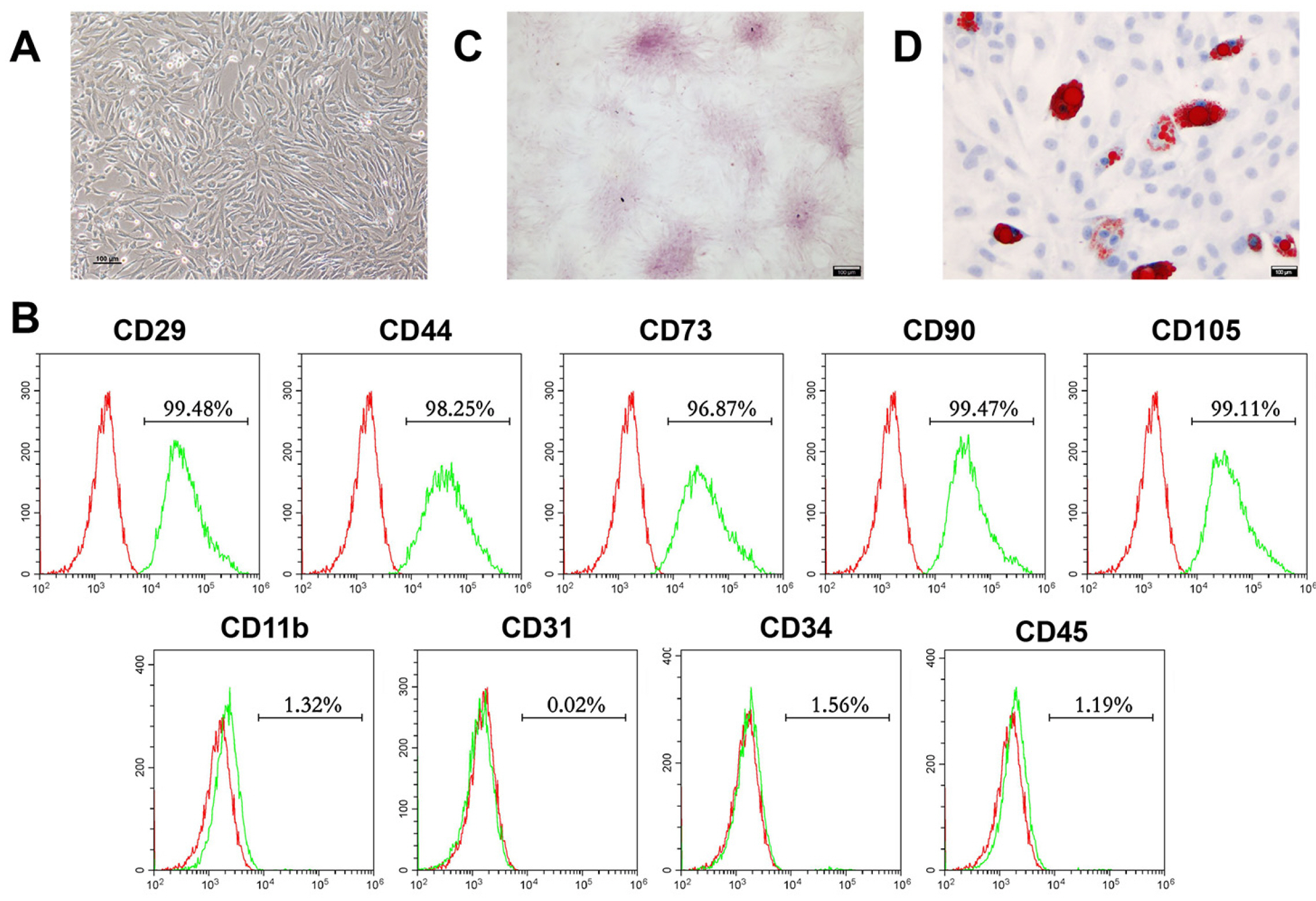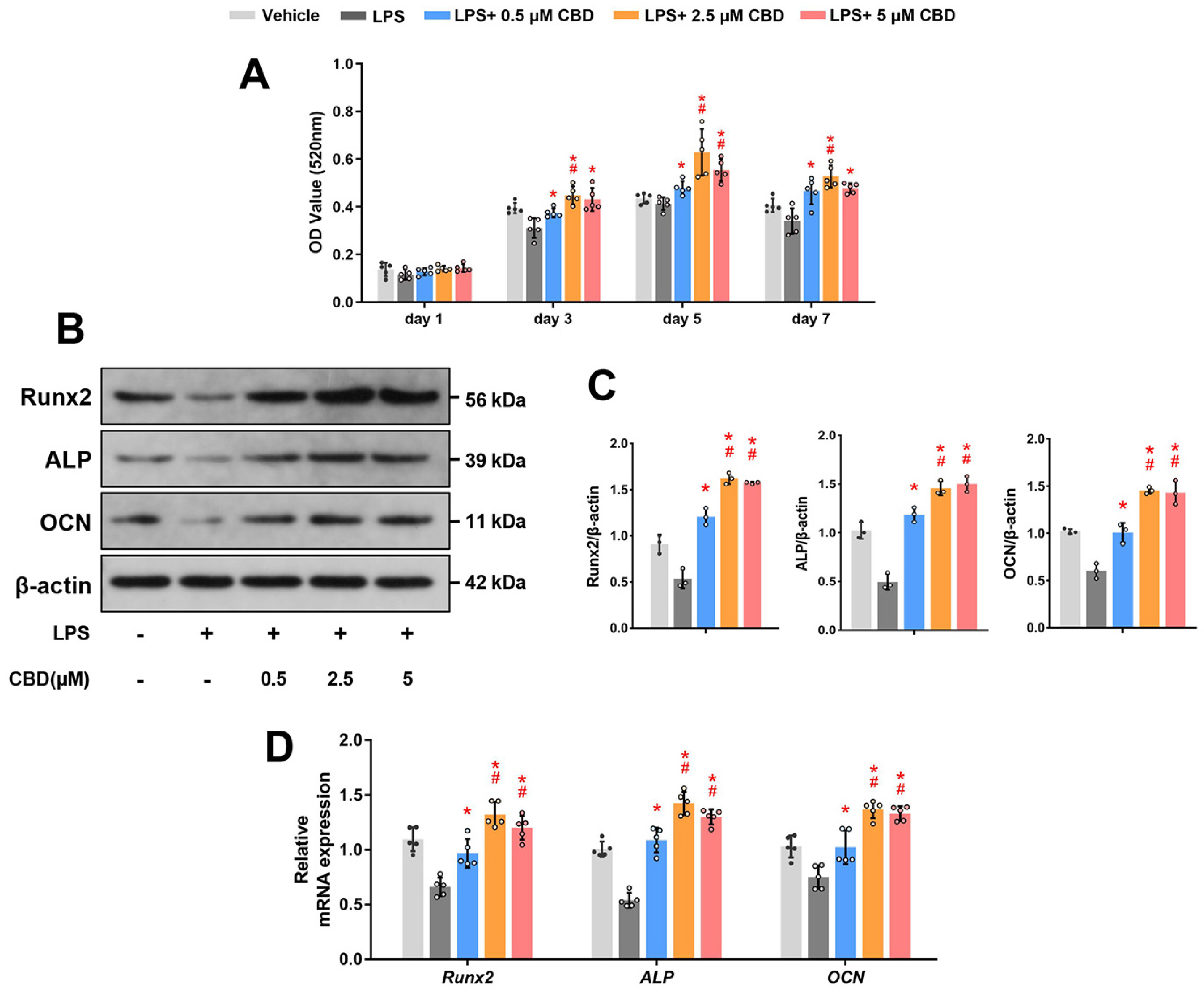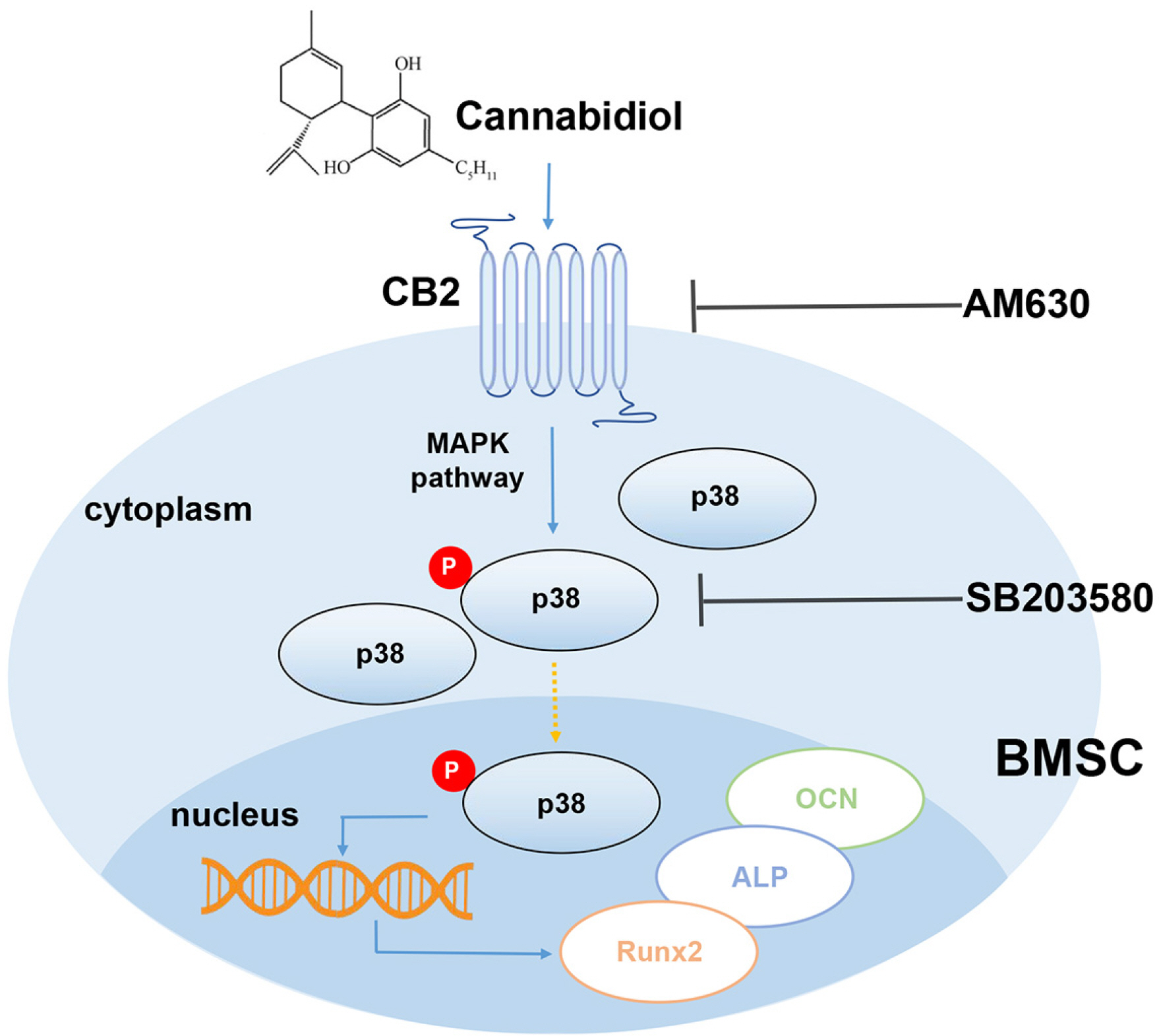Int J Stem Cells.
2022 Nov;15(4):405-414. 10.15283/ijsc21152.
Cannabidiol Promotes Osteogenic Differentiation of Bone Marrow Mesenchymal Stem Cells in the Inflammatory Microenvironment via the CB2-dependent p38 MAPK Signaling Pathway
- Affiliations
-
- 1Medical School of Chinese PLA, Beijing, China
- 2Department of Stomatology, The First Medical Center, Chinese PLA General Hospital, Beijing, China
- 3Department of Stomatology, Medical Center of Chinese People’s Liberation Army Strategic Support Force, Beijing, China
- 4Department of Stomatology, Fuxing Hospital, Capital Medical University, Beijing, China
- 5Department of Oncology, Affiliated Hospital of Hebei University, Hebei Key Laboratory of Cancer Radiotherapy and Chemotherapy, Baoding, China
- KMID: 2536210
- DOI: http://doi.org/10.15283/ijsc21152
Abstract
- Background and Objectives
Chronic inflammation of bone tissue often results in bone defects and hazards to tissue repair and regeneration. Cannabidiol (CBD) is a natural cannabinoid with multiple biological activities, including anti-inflammatory and osteogenic potential. This study aimed to investigate the efficacy and mechanisms of CBD in the promotion of bone marrow mesenchymal stem cells (BMSCs) osteogenic differentiation in the inflammatory microenvironment.
Methods and Results
BMSCs isolated from C57BL/6 mice, expressed stem cell characteristic surface markers and pre-sented multidirectional differentiation potential. The CCK-8 assay was applied to evaluate the effects of CBD on BMSCs’ vitality, and demonstrating the safety of CBD on BMSCs. Then, BMSCs were stimulated with lipopolysaccharide (LPS) to induce inflammatory microenvironment. We found that CBD intervention down-regulated mRNA expression levels of inflammatory cytokines and promoted cells proliferation in LPS-treated BMSCs, also reversed the protein and mRNA levels downregulation of osteogenic markers caused by LPS treatment. Moreover, CBD intervention activated the cannabinoid receptor 2 (CB2) and the p38 mitogen-activated protein kinase (MAPK) signaling pathway. While AM630, a selective CB2 inhibitor, reduced phosphorylated (p)-p38 levels. In addition, AM630 and SB530689, a selective p38 MAPK inhibitor, attenuated the enhancement of osteogenic markers expression levels by CBD in inflammatory microenvironment, respectively.
Conclusions
CBD promoted osteogenic differentiation of BMSCs via the CB2/p38 MAPK signaling pathway in the inflammatory microenvironment.
Keyword
Figure
Reference
-
References
1. Liu H, Li D, Zhang Y, Li M. 2018; Inflammation, mesenchymal stem cells and bone regeneration. Histochem Cell Biol. 149:393–404. DOI: 10.1007/s00418-018-1643-3. PMID: 29435765. PMID: https://www.scopus.com/inward/record.uri?partnerID=HzOxMe3b&scp=85041915808&origin=inward.
Article2. Redlich K, Smolen J. 2012; Inflammatory bone loss: pathogenesis and therapeutic intervention. Nat Rev Drug Discov. 11:234–250. DOI: 10.1038/nrd3669. PMID: 22378270. PMID: https://www.scopus.com/inward/record.uri?partnerID=HzOxMe3b&scp=84857737880&origin=inward.
Article3. Zaidi M, Sun L, Blair HC. 2012; Special stem cells for bone. Cell Stem Cell. 10:233–234. DOI: 10.1016/j.stem.2012.02.012. PMID: 22385649. PMID: https://www.scopus.com/inward/record.uri?partnerID=HzOxMe3b&scp=84857835052&origin=inward.
Article4. Fierro FA, Nolta JA, Adamopoulos IE. 2017; Concise review: stem cells in osteoimmunology. Stem Cells. 35:1461–1467. DOI: 10.1002/stem.2625. PMID: 28390147. PMCID: PMC6047890. PMID: https://www.scopus.com/inward/record.uri?partnerID=HzOxMe3b&scp=85018752721&origin=inward.
Article5. Liu D, Xu J, Liu O, Fan Z, Liu Y, Wang F, Ding G, Wei F, Zhang C, Wang S. 2012; Mesenchymal stem cells derived from inflamed periodontal ligaments exhibit impaired immuno-modulation. J Clin Periodontol. 39:1174–1182. DOI: 10.1111/jcpe.12009. PMID: 23005571. PMID: https://www.scopus.com/inward/record.uri?partnerID=HzOxMe3b&scp=84869506142&origin=inward.
Article6. Zaidi M. 2007; Skeletal remodeling in health and disease. Nat Med. 13:791–801. DOI: 10.1038/nm1593. PMID: 17618270. PMID: https://www.scopus.com/inward/record.uri?partnerID=HzOxMe3b&scp=34447132814&origin=inward.
Article7. Izzo A, Borrelli F, Capasso R, Di Marzo V, Mechoulam R. 2009; Non-psychotropic plant cannabinoids: new therapeutic opportunities from an ancient herb. Trends Pharmacol Sci. 30:515–527. Erratum in: Trends Pharmacol Sci 2009; 30:609. DOI: 10.1016/j.tips.2009.07.006. PMID: 19729208. PMID: https://www.scopus.com/inward/record.uri?partnerID=HzOxMe3b&scp=70349189518&origin=inward.
Article8. Miranzadeh Mahabadi H, Bhatti H, Laprairie RB, Taghibiglou C. 2021; Cannabinoid receptors distribution in mouse cortical plasma membrane compartments. Mol Brain. 14:89. DOI: 10.1186/s13041-021-00801-x. PMID: 34099009. PMCID: PMC8183067. PMID: 1f1d3f61cff34f2aaf14b402ed126261. PMID: https://www.scopus.com/inward/record.uri?partnerID=HzOxMe3b&scp=85107703483&origin=inward.
Article9. Kozela E, Juknat A, Gao F, Kaushansky N, Coppola G, Vogel Z. 2016; Pathways and gene networks mediating the regulatory effects of cannabidiol, a nonpsychoactive cannabinoid, in autoimmune T cells. J Neuroinflammation. 13:136. DOI: 10.1186/s12974-016-0603-x. PMID: 27256343. PMCID: PMC4891926. PMID: https://www.scopus.com/inward/record.uri?partnerID=HzOxMe3b&scp=84975252811&origin=inward.
Article10. Couch D, Tasker C, Theophilidou E, Lund J, O'Sullivan S. 2017; Cannabidiol and palmitoylethanolamide are anti-inflammatory in the acutely inflamed human colon. Clin Sci (Lond). 131:2611–2626. DOI: 10.1042/CS20171288. PMID: 28954820. PMID: https://www.scopus.com/inward/record.uri?partnerID=HzOxMe3b&scp=85032825924&origin=inward.
Article11. Huang Y, Wan T, Pang N, Zhou Y, Jiang X, Li B, Gu Y, Huang Y, Ye X, Lian H, Zhang Z, Yang L. 2019; Cannabidiol protects livers against nonalcoholic steatohepatitis induced by high-fat high cholesterol diet via regulating NF-κB and NLRP3 inflammasome pathway. J Cell Physiol. 234:21224–21234. DOI: 10.1002/jcp.28728. PMID: 31032942. PMID: https://www.scopus.com/inward/record.uri?partnerID=HzOxMe3b&scp=85065202604&origin=inward.
Article12. Jastrząb A, Gęgotek A, Skrzydlewska E. 2019; Cannabidiol regulates the expression of keratinocyte proteins involved in the inflammation process through transcriptional regulation. Cells. 8:827. DOI: 10.3390/cells8080827. PMID: 31382646. PMCID: PMC6721680. PMID: https://www.scopus.com/inward/record.uri?partnerID=HzOxMe3b&scp=85075255665&origin=inward.
Article13. Philpott H, O'Brien M, McDougall J. 2017; Attenuation of early phase inflammation by cannabidiol prevents pain and nerve damage in rat osteoarthritis. Pain. 158:2442–2451. DOI: 10.1097/j.pain.0000000000001052. PMID: 28885454. PMCID: PMC5690292. PMID: https://www.scopus.com/inward/record.uri?partnerID=HzOxMe3b&scp=85040536264&origin=inward.
Article14. Verrico C, Wesson S, Konduri V, Hofferek C, Vazquez-Perez J, Blair E, Dunner K Jr, Salimpour P, Decker WK, Halpert MM. 2020; A randomized, double-blind, placebo-controlled study of daily cannabidiol for the treatment of canine osteoarthritis pain. Pain. 161:2191–2202. DOI: 10.1097/j.pain.0000000000001896. PMID: 32345916. PMCID: PMC7584779. PMID: https://www.scopus.com/inward/record.uri?partnerID=HzOxMe3b&scp=85089730228&origin=inward.
Article15. Apostu D, Lucaciu O, Mester A, Benea H, Oltean-Dan D, Onisor F, Baciut M, Bran S. 2019; Cannabinoids and bone regener-ation. Drug Metab Rev. 51:65–75. DOI: 10.1080/03602532.2019.1574303. PMID: 30702341. PMID: https://www.scopus.com/inward/record.uri?partnerID=HzOxMe3b&scp=85065787113&origin=inward.
Article16. Saint-Pastou Terrier C, Gasque P. 2017; Bone responses in health and infectious diseases: a focus on osteoblasts. J Infect. 75:281–292. DOI: 10.1016/j.jinf.2017.07.007. PMID: 28778751. PMID: https://www.scopus.com/inward/record.uri?partnerID=HzOxMe3b&scp=85028068866&origin=inward.
Article17. Yang Y, Dong X, Ma W, Guan L, Wang YH, Huang XH, Chen JF, Zhao X. 2020; Proliferation, differentiation and immunoregulatory capacities of brown and white adipose-derived stem cells from young and aged mice. Int J Stem Cells. 13:246–256. DOI: 10.15283/ijsc20019. PMID: 32323515. PMCID: PMC7378905. PMID: https://www.scopus.com/inward/record.uri?partnerID=HzOxMe3b&scp=85107662100&origin=inward.
Article18. Yang S, Zhu B, Yin P, Zhao L, Wang Y, Fu Z, Dang R, Xu J, Zhang J, Wen N. 2020; Integration of human umbilical cord mesenchymal stem cells-derived exosomes with hydroxyapatite-embedded hyaluronic acid-alginate hydrogel for bone regeneration. ACS Biomater Sci Eng. 6:1590–1602. DOI: 10.1021/acsbiomaterials.9b01363. PMID: 33455380. PMID: https://www.scopus.com/inward/record.uri?partnerID=HzOxMe3b&scp=85080064922&origin=inward.
Article19. Libro R, Scionti D, Diomede F, Marchisio M, Grassi G, Pollastro F, Piattelli A, Bramanti P, Mazzon E, Trubiani O. 2016; Cannabidiol modulates the immunophenotype and inhibits the activation of the inflammasome in human gingival mesenchymal stem cells. Front Physiol. 7:559. DOI: 10.3389/fphys.2016.00559. PMID: 27932991. PMCID: PMC5121123. PMID: https://www.scopus.com/inward/record.uri?partnerID=HzOxMe3b&scp=84997079293&origin=inward.
Article20. Yu X, Quan J, Long W, Chen H, Wang R, Guo J, Lin X, Mai S. 2018; LL-37 inhibits LPS-induced inflammation and sti-mulates the osteogenic differentiation of BMSCs via P2X7 receptor and MAPK signaling pathway. Exp Cell Res. 372:178–187. DOI: 10.1016/j.yexcr.2018.09.024. PMID: 30287143. PMID: https://www.scopus.com/inward/record.uri?partnerID=HzOxMe3b&scp=85054468907&origin=inward.
Article21. Qian H, Zhao Y, Peng Y, Han C, Li S, Huo N, Ding Y, Duan Y, Xiong L, Sang H. 2010; Activation of cannabinoid receptor CB2 regulates osteogenic and osteoclastogenic gene expression in human periodontal ligament cells. J Periodontal Res. 45:504–511. DOI: 10.1111/j.1600-0765.2009.01265.x. PMID: 20412420. PMID: https://www.scopus.com/inward/record.uri?partnerID=HzOxMe3b&scp=77954835749&origin=inward.
Article22. Bab I, Zimmer A. 2008; Cannabinoid receptors and the regulation of bone mass. Br JPharmacol. 153:182–188. DOI: 10.1038/sj.bjp.0707593. PMID: 18071301. PMCID: PMC2219540. PMID: https://www.scopus.com/inward/record.uri?partnerID=HzOxMe3b&scp=38349132542&origin=inward.
Article23. Idris A, Greig I, Ridge S, Baker D, Ross R, Ralston SH. van't Hof R. 2005; Regulation of bone mass, bone loss and osteoclast activity by cannabinoid receptors. Nat Med. 11:774–779. DOI: 10.1038/nm1255. PMID: 15908955. PMCID: PMC1430341. PMID: https://www.scopus.com/inward/record.uri?partnerID=HzOxMe3b&scp=22544439953&origin=inward.
Article24. Gibon E, Lu L, Goodman SB. 2016; Aging, inflammation, stem cells, and bone healing. Stem Cell Res Ther. 7:44. DOI: 10.1186/s13287-016-0300-9. PMID: 27006071. PMCID: PMC4804630. PMID: https://www.scopus.com/inward/record.uri?partnerID=HzOxMe3b&scp=85007328357&origin=inward.
Article25. Britch S, Babalonis S, Walsh S. 2021; Cannabidiol: pharmacology and therapeutic targets. Psychopharmacology (Berl). 238:9–28. DOI: 10.1007/s00213-020-05712-8. PMID: 33221931. PMCID: PMC7796924. PMID: https://www.scopus.com/inward/record.uri?partnerID=HzOxMe3b&scp=85096377435&origin=inward.
Article26. Schmuhl E, Ramer R, Salamon A, Peters K, Hinz B. 2014; Increase of mesenchymal stem cell migration by cannabidiol via activation of p42/44 MAPK. Biochem Pharmacol. 87:489–501. DOI: 10.1016/j.bcp.2013.11.016. PMID: 24304686. PMID: https://www.scopus.com/inward/record.uri?partnerID=HzOxMe3b&scp=84892913775&origin=inward.
Article27. Qi X, Liu C, Li G, Luan H, Li S, Yang D, Zhou Z. 2021; Investi-gation of in vitro odonto/osteogenic capacity of cannabidiol on human dental pulp cell. J Dent. 109:103673. DOI: 10.1016/j.jdent.2021.103673. PMID: 33872753. PMID: https://www.scopus.com/inward/record.uri?partnerID=HzOxMe3b&scp=85104932079&origin=inward.
Article28. Kamali A, Oryan A, Hosseini S, Ghanian MH, Alizadeh M, Baghaban Eslaminejad M, Baharvand H. 2019; Cannabidiol-loaded microspheres incorporated into osteoconductive scaffold enhance mesenchymal stem cell recruitment and regenera-tion of critical-sized bone defects. Mater Sci Eng C Mater Biol Appl. 101:64–75. Erratum in: Mater Sci Eng C Mater Biol Appl 2021;126:112179. DOI: 10.1016/j.msec.2021.112179. PMID: 34082979. PMID: https://www.scopus.com/inward/record.uri?partnerID=HzOxMe3b&scp=85105597418&origin=inward.
Article29. Idris A, Sophocleous A, Landao-Bassonga E, Ralston S. van't Hof R. 2008; Regulation of bone mass, osteoclast function, and ovariectomy-induced bone loss by the type 2 cannabinoid receptor. Endocrinology. 149:5619–5626. DOI: 10.1210/en.2008-0150. PMID: 18635663. PMID: https://www.scopus.com/inward/record.uri?partnerID=HzOxMe3b&scp=54349124546&origin=inward.
Article30. Scutt A, Williamson EM. 2007; Cannabinoids stimulate fibroblastic colony formation by bone marrow cells indirectly via CB2 receptors. Calcif Tissue Int. 80:50–59. DOI: 10.1007/s00223-006-0171-7. PMID: 17205329. PMID: https://www.scopus.com/inward/record.uri?partnerID=HzOxMe3b&scp=33846223892&origin=inward.
Article31. Wang J, Lu HX, Wang J. 2019; Cannabinoid receptors in osteoporosis and osteoporotic pain: a narrative update of review. J Pharm Pharmacol. 71:1469–1474. DOI: 10.1111/jphp.13135. PMID: 31294469. PMID: https://www.scopus.com/inward/record.uri?partnerID=HzOxMe3b&scp=85068754820&origin=inward.
Article32. Yan W, Cao Y, Yang H, Han N, Zhu X, Fan Z, Du J, Zhang F. 2019; CB1 enhanced the osteo/dentinogenic differentiation ability of periodontal ligament stem cells via p38 MAPK and JNK in an inflammatory environment. Cell Prolif. 52:e12691. DOI: 10.1111/cpr.12691. PMID: 31599069. PMCID: PMC6869632. PMID: https://www.scopus.com/inward/record.uri?partnerID=HzOxMe3b&scp=85074025816&origin=inward.
Article33. Navarro G, Reyes-Resina I, Rivas-Santisteban R, Sánchez de Medina V, Morales P, Casano S, Ferreiro-Vera C, Lillo A, Aguinaga D, Jagerovic N, Nadal X, Franco R. 2018; Cannabidiol skews biased agonism at cannabinoid CB1 and CB2 receptors with smaller effect in CB1-CB2 heteroreceptor complexes. Biochem Pharmacol. 157:148–158. DOI: 10.1016/j.bcp.2018.08.046. PMID: 30194918. PMID: https://www.scopus.com/inward/record.uri?partnerID=HzOxMe3b&scp=85054580335&origin=inward.
Article34. Kang M, Lee J, Park S. 2020; Cannabidiol induces osteoblast differentiation via angiopoietin1 and p38 MAPK. Environ Toxicol. 35:1318–1325. DOI: 10.1002/tox.22996. PMID: 32656944. PMID: https://www.scopus.com/inward/record.uri?partnerID=HzOxMe3b&scp=85087769001&origin=inward.
Article35. Rahaman O, Ganguly D. 2021; Endocannabinoids in immune regulation and immunopathologies. Immunology. 164:242–252. DOI: 10.1111/imm.13378. PMID: 34053085. PMCID: PMC8442232. PMID: https://www.scopus.com/inward/record.uri?partnerID=HzOxMe3b&scp=85109373575&origin=inward.
Article36. Wang B, Li J, Mei G. LianK. 2018; Restoration of osteogenic differentiation by overexpression of cannabinoid receptor 2 in bone marrow mesenchymal stem cells isolated from osteoporotic patients. Exp Ther Med. 15:357–364. DOI: 10.3892/etm.2017.5369. PMID: 29250156. PMCID: PMC5729701. PMID: https://www.scopus.com/inward/record.uri?partnerID=HzOxMe3b&scp=85035117950&origin=inward.
Article37. Ge C, Yang Q, Zhao G, Yu H, Kirkwood KL, Franceschi RT. 2021; Interactions between extracellular signal-regulated kinase 1/2 and P38 MAP kinase pathways in the control of RUNX2 phosphorylation and transcriptional activity. J Bone Miner Res. 36:2096–2097. Erratum in: J Bone Miner Res 2012;27:538-551. DOI: 10.1002/jbmr.561. PMID: 22072425. PMCID: PMC4285380. PMID: https://www.scopus.com/inward/record.uri?partnerID=HzOxMe3b&scp=84857320794&origin=inward.
Article38. Whyte L, Ryberg E, Sims N, Ridge S, Mackie K, Greasley P, Ross RA, Rogers MJ. 2009; The putative cannabinoid receptor GPR55 affects osteoclast function in vitro and bone mass in vivo. Proc Natl Acad Sci U S A. 106:16511–16516. DOI: 10.1073/pnas.0902743106. PMID: 19805329. PMCID: PMC2737440. PMID: https://www.scopus.com/inward/record.uri?partnerID=HzOxMe3b&scp=70349510641&origin=inward.
Article
- Full Text Links
- Actions
-
Cited
- CITED
-
- Close
- Share
- Similar articles
-
- Nectandrin A Enhances the BMP-Induced Osteoblastic Differentiation and Mineralization by Activation of p38 MAPK-Smad Signaling Pathway
- IGF-1 Induces Osteogenic Differentiation of Rat Bone Marrow Mesenchymal Stem Cells by Promoting SOX4 via the MAPK/ERK Pathway
- Synergistic Effect of Hydrogen and 5-Aza on Myogenic Differentiation through the p38 MAPK Signaling Pathway in Adipose-Derived Mesenchymal Stem Cells
- Carnosol induces the osteogenic differentiation of bone marrowderived mesenchymal stem cells via activating BMP-signaling pathway
- Exploring upregulated genes during osteogenic differentiation of hMSCs







